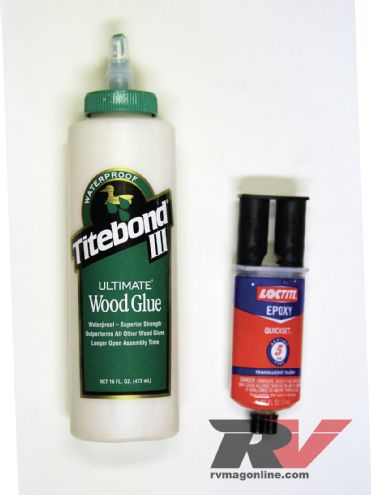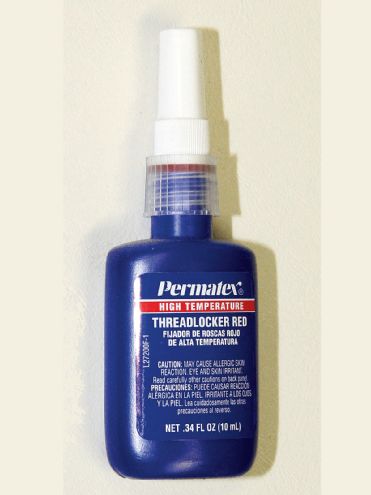As anyone who owns an RV knows, stuff falls off and breaks on a regular basis. It’s a tough environment bouncing your living quarters down the bumpy roads. Duct tape may work to get you there, but sooner or later you’re going to have to repair it properly. There are a number of methods used to hold things together, but not every technique works for every application. Each has its place.
Welding
Welding involves heating two metals and adding a third metal to melt everything together. The end result is that it’s as good as new and all molded as one piece, with no crack or joint remaining. Generally, this is done with an electric arc to heat up the metal and an electrode or wire that melts into the cavity and flows to metal into the two pieces being welded together. Care must be used to disconnect any ECM or other computerized circuits prior to welding to prevent damage to those components. Welding is great for trailer hitches and other heavy-duty metal works.

| Welding is the strongest method of fastening because both pieces become one. The drawback to welding is that it’s fairly permanent. The pieces cannot be removed or separated without extensive labor.
A lesser known task is plastic welding. Plastic welders use heat to melt plastic and a selection of various plastic filler rods to fill in and join them together. A plastic welder can be a real lifesaver if you have a cracked fan shroud, ABS or urethane bumper, or even a stripped screw hole in a plastic dash component.

| Plastic welding kits are available to repair any kind of plastic material. They are great for repairing cracked items or for restoring a stripped screw hole.
Glues
Glues can be a one-step process, such as a super glue or woodworking glue, or they can be a two-step process, known as epoxies. The two-step process forms a stronger bond, but equal parts of the base and hardener need to be mixed and then used quickly before it dries. It’s great for light-duty tasks that need to set quickly, but be sure not to mix any more than you need because it will harden within a short period of time. Glues and epoxies have a limited range of applications, so be sure to check the label to determine which one is suitable for your particular application.

| 3M’s Super 77 spray adhesive is an excellent choice for attaching loose wall coverings, rubber, or fabrics.
Nuts and Bolts
Bolts depend on clamping force to hold things together. Bolts come in many diameters and lengths to fit most any need. Bolts are also graded, with Grade 5 bolts being good general-purpose fasteners and Grade 8 bolts being used for higher tensile strength applications. A bolt is dropped into a pre-drilled hole and a nut is threaded to the opposite end. The secret is to prevent the nut from loosening up. Lock washers help prevent that by biting into the metal. In some cases, a bolt is used as a ground stud so a star lock washer provides more area to conduct electricity and is best suited for electrical terminals.

| A nylon lock nut will prevent the nut from backing off of a bolt and is the perfect choice for any applications that require low clamping force. Self-drilling screws eliminate having to drill a pilot hole and are very popular in RVs.
The ideal solution is a nylon lock nut. These durable fasteners have a nylon ring attached to one end of the nut. This undersized nylon ring grips the bolt’s threads to prevent it from loosening. Another advantage of a nylon lock nut is that it remains tight, even when tension is removed, unlike a typical lock washer, which requires tension in order to hold. This is perfect for anything that moves or swells and shrinks occasionally.
Screws and Rivets
Screws also use clamping force, but rather than have a nut on the far end, they rely on threads cut into the material being held. The fasteners holding power is going to depend on how thick the material is that is being fastened. Thicker materials have more room for thread and will have a better holding power than when used in thinner material. The biggest benefit is that they do not require a nut, so access from one side is possible. Standard screws require a small pilot hole, but self-tapping screws come with a drill bit tip to self-drill the hole. Ideally, these screws will have hex heads, Phillips heads, or square drive heads to allow power tool installation.

| Blind rivets are applied from one side so no access to the rear is required. They work well in thin materials, such as sheetmetal or fiberglass, and develop their strength by expanding on the backside of the material.
Screws are not ideal if the material is too thin or too soft, so screws are not the best choice if you are mounting a satellite dish or solar panel to an RV with a thin fiberglass roof. The threads in the thin fiberglass can strip and the screws will pull out. In this case, a rivet is a better option. Rivets expand when tightened with their installation tool. The big benefit is that they expand and tighten on the backside rather than cut threads into the material. They achieve their clamping force similar to a nut and bolt but can be blind-installed from one side without requiring access to the backside to hold the nut. This gives them the ability to maintain good clamping force in thinner materials.
You may be able to use a screw anchor in cases where a rivet is not desired or esthetically pleasing. Anchors function by installing into thin material and expanding, very similar to a rivet. However, the anchor will then accept a screw and will provide additional room for the threads.
Choosing the correct fastener will go a long way toward making your repair a permanent one. Even so, I wouldn’t leave home without that roll of duct tape.

